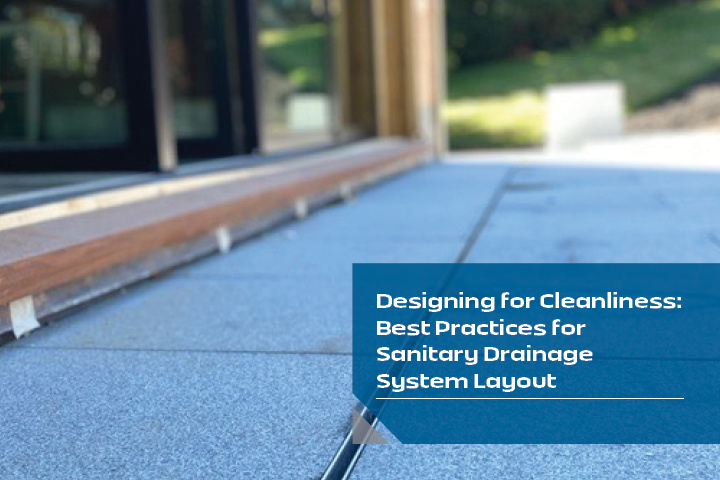Drainage is essential to maintaining safe, dry indoor and outdoor spaces. While there are many forms of drainage, sanitary drainage systems are very common and critical to ensuring that buildings and properties maintain adequate sanitation and cleanliness.
Unlike a basic drainage system, a sanitary system has stricter requirements in terms of design and layout. Adhering to the requirements is essential for ensuring a reliable design that properly meets the requirements and functions. Here is what you should know about sanitary drainage systems.
What is a Sanitary Drainage System? Why is it Important?
A sanitary drainage system is designed to handle sewage or other liquid waste. These systems consist of a series of pipes that transport waste to a designated disposal outlet. The design of these systems is meant to ensure the highest level of sanitation and cleanliness possible, and they are commonly found in bathrooms, public spaces, and various commercial facilities and industries.
Sanitary drainage systems play a significant role in maintaining safe, sanitary environments that are free from harmful bacteria and contamination.
What is Required for a Sanitary Drainage System?
When designing a sanitary drainage system, it is essential to study the plumbing standards and codes, both the model and regional variations, which help to determine factors like the layout and size of an interior sanitary drainage system. Some of those standards and codes include:
Slope
One crucial requirement of sanitary drainage systems is ensuring that there is a uniform slope to the system's layout to allow for a minimum drainage speed of 2 feet per second. This speed, combined with the appropriate pipe sizing, is intended to keep solid waste in suspension so that it will not settle at the bottom of the pipe, which can lead to a drain stoppage. Another requirement for sanitary drainage system layouts to further prevent stoppages or obstructions is ensuring that the pipe sizing is consistent and there are no reductions in the flow direction.
Drain Fittings
For a drainage system to change direction, the system must use the appropriate fittings, which are determined by the design patterns that provide the least flow resistance.
For horizontal system layouts, long-pattern fittings are necessary because they help prevent any excessive reduction in flow rates. If the system flows in horizontal-to-vertical layouts, shorter fittings are preferred to help accelerate the flow.
Aside from choosing the right size of fittings for your system, you must ensure the fittings are compatible with the piping materials and slope in the appropriate direction without anything that may obstruct the flow.
Sizing
The size of a sanitary drainage system's piping is based on fixture unit values, which take into account factors like the rate of discharge, the duration of use for an operation, and intervals between each use.
Ideally, for an economical design, a system should use the smallest accepted pipe sizing according to the codes for the given application. The sizing should allow for wastewater to move through the system efficiently without any concern of clogging.
Materials
Choosing the right materials for a sanitary drainage system is also critical. Different materials have their appropriate applications, so it is vital to take the time to consider the desired location and use of the system.
While PVC can work in many scenarios if you require more durability and corrosion resistance, options like stainless steel are ideal.
Sanitation Considerations
Maintaining clean and sanitary drains is essential and made easier with the appropriate materials. Avoiding rough surfaces prone to corrosion, like brass and iron, is important for avoiding bacteria buildup and potential contamination. If your drain channel is made from these materials, an enamel coating is necessary to create a smooth, durable interior. Ideally, consider opting for one of the more durable material options like stainless steel for the body and any necessary grain covers to avoid extra expenses and work in maintaining a sanitary system.
Sanitary Drainage with the Slot Drain System
When looking for appropriate sanitary drainage, Slot Drain Systems offers many systems suitable for various applications. Slot Drain systems meet all of the codes and standards related to a sanitary drainage system layout, with the system coming pre-assembled and pre-sloped, with the correct slope in mind for adequate flow. The linear design of the systems further ensures a sanitary drainage system layout that functions and flows smoothly.
Similar in some ways to a traditional trench drain system, the Slot Drain does not require a grate cover, with channel openings in three widths: 1/2-inch, 1-inch, and 1-1/4-inch. Each offers an efficient flow rate of 11, 18, and 27 gallons per minute per foot of drain, respectively.
While the various models are available in different materials, they virtually all offer nonporous T304 and T316 stainless steel builds for sanitary applications, which provide bacteria, heat, and odor resistance.
Taking the Time to Ensure the Proper Sanitary Drainage Layout
There is no denying the importance of a sanitary drainage system. Sanitary drainage systems play a significant role in maintaining and preventing the spread of bacteria and contamination, to help ensure a clean, safe environment. Many factors make a system sanitary, from the materials they use to its overall design and layout. This article briefly examines these factors, but much more is needed.
Contact the team at Slot Drain Systems today to learn more about the Slot Drain, their different systems, and how they meet the sanitary drainage layout codes and standards!



